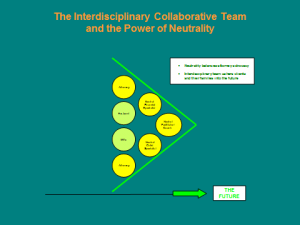
As a confirmed New Yorker subscriber, I enjoy the cartoons as much as the writing. Indeed, the cartoons alone would justify my subscription. Earlier this year, there was a drawing of a customer addressing a florist.
“I want some flowers that say, ‘Here! Have some frickin’ flowers!'”
For a lot of couples about to enter into a dissolution of their marriage, the holidays are a time of high anxiety. Often, both spouses know it’s coming–soon–but call a truce in order not to wreck the children’s Christmas.
According to some of my former clients who have done that, the whole holiday season felt like, “Here! Have a frickin’ truce!”
Tense, hollow, sarcastic. Anxiety-ridden, courtesy of the Unknown.
A close friend who knows about my practice once asked me, “What’s the most important thing you can tell someone who comes in to see you about a divorce?”
“Well, it will depend on what’s most important to that person at that moment, but, generally speaking, I’d want them to know it’s going to be all right,” I said.
“Isn’t that a little misleading? I mean, you don’t know anything about who they’re married to, or who that person’s lawyer is, or anything.”
“Well, I know this: when they talk to me, they’re living in a situation that’s become unbearable, a situation they know very well. And it’s bad enough that they’re talking to me about an Unknown–the divorce–that they’d rather deal with. I actually did once ask a client who was complaining about how long it was taking and how much it was costing whether he’d like to dismiss the action and stay married. He looked at me like I had two heads. ‘Not on the longest day you live,’ he said.”
So the goal was not an issue. By the way, that was before I began doing Collaborative cases. But my point is that the divorce itself will end some day, and probably in less than a year. And after it’s over, that person will go on with their life.
Most of the time, the people who come to me know that I do mostly Collaborative cases, where the couples have to agree on what happens before anything can happen, and where the goal is to agree on all the terms of the divorce. So they each have to give their spouse a reason to agree to what they’re seeking. More importantly, they have many opportunities over the weeks of that case to refine the conversation, discover what’s at the heart of their goals, and explore different ways of satisfying their spouse’s interests.
The upshot is that by the time they do reach all their agreements, they have talked everything through–usually multiple times–and they have a set of agreements they can live with. And things going forward are going to be all right! They can take some reassurance in that because their discussions were all based on their actual situation, not what they wish their situation was. They’ve spoken with their lawyers and they understand what the courts can do and what they won’t do.
In the Decree, under “real estate,” the court simply can’t award to the spouse who had an affair “the hottest corner of Hell.” For one thing, there’s no legal description. But if their husband or wife insists that this is the only appropriate residence for them, post-decree, I know that person will never succeed in a Collaborative case. I also know that person won’t “succeed” in court, either. And, finally, I know that person could care less if things turn out “all right,” because their highest priority is to give back the pain they feel to the person who, they believe, caused it. They almost certainly will get more help from a therapist than a lawyer.
But for the potential client who is most interested in ending their marriage, attending to their affairs, and starting a new life, history teaches us, time and again, that, really, it will be all right.
At least, that’s what my clients tell me.
 I am often asked to give presentations on the financial issues in divorce. I always cover what I refer to as the two financial pillars of any divorce dividing property including debts and cash flow and support. Without fail someone in attendance always asks where, do I begin? I do not know where to start. This question is asked not from a financial viewpoint but from an overall perspective of where to begin.
My response is virtually the same every time. The most important decision you have to make is the decision to end the marriage. Some take months or even years to make this decision. It is not an easy one.
If the decision is made to divorce, then the next most important decision is how to do it. What process options are available and which might be best suited for me, my spouse, and if children are present. Again not an easy decision, especially since these types of decisions are often made during times of high emotions including hurt, pain, and even anger. This is not necessarily the best frame of mind for making such life changing decisions.
Having experienced divorce after a 30-year marriage and in my professional experience as a financial neutral, financial mediator, and supporting individual clients and their attorneys, the answer where to begin may be somewhere not so obvious, a divorce coach trained in collaborative divorce. I say this not because you will end up or be steered to a collaborative divorce, but rather that a divorce coach can help you and your spouse navigate the emotions and challenges during any divorce process and beyond.
A collaboratively trained divorce coach can help explain process options in a manner to help you no matter what process you may choose. A neutral divorce coach can also help recommend other divorce professionals including a child specialist, financial specialist, and attorneys who can work together with you and your spouse in any divorce process. In addition, a divorce coach can help save you time, money, and heartache by guiding you and helping you manage emotions throughout the process.
How do I find a collaboratively trained divorce coach? Click here to find coaches throughout the MSP metro area. By clicking on their name, you can read their profiles. Many, if not all of them, will provide a free initial consultation allowing you to ask questions, evaluate each individual and make informed decisions best suited to you and your family. Divorce coaches are one of the best resources available to anyone considering divorce and wondering “where do I begin.”
I am often asked to give presentations on the financial issues in divorce. I always cover what I refer to as the two financial pillars of any divorce dividing property including debts and cash flow and support. Without fail someone in attendance always asks where, do I begin? I do not know where to start. This question is asked not from a financial viewpoint but from an overall perspective of where to begin.
My response is virtually the same every time. The most important decision you have to make is the decision to end the marriage. Some take months or even years to make this decision. It is not an easy one.
If the decision is made to divorce, then the next most important decision is how to do it. What process options are available and which might be best suited for me, my spouse, and if children are present. Again not an easy decision, especially since these types of decisions are often made during times of high emotions including hurt, pain, and even anger. This is not necessarily the best frame of mind for making such life changing decisions.
Having experienced divorce after a 30-year marriage and in my professional experience as a financial neutral, financial mediator, and supporting individual clients and their attorneys, the answer where to begin may be somewhere not so obvious, a divorce coach trained in collaborative divorce. I say this not because you will end up or be steered to a collaborative divorce, but rather that a divorce coach can help you and your spouse navigate the emotions and challenges during any divorce process and beyond.
A collaboratively trained divorce coach can help explain process options in a manner to help you no matter what process you may choose. A neutral divorce coach can also help recommend other divorce professionals including a child specialist, financial specialist, and attorneys who can work together with you and your spouse in any divorce process. In addition, a divorce coach can help save you time, money, and heartache by guiding you and helping you manage emotions throughout the process.
How do I find a collaboratively trained divorce coach? Click here to find coaches throughout the MSP metro area. By clicking on their name, you can read their profiles. Many, if not all of them, will provide a free initial consultation allowing you to ask questions, evaluate each individual and make informed decisions best suited to you and your family. Divorce coaches are one of the best resources available to anyone considering divorce and wondering “where do I begin.”  I am often asked to give presentations on the financial issues in divorce. I always cover what I refer to as the two financial pillars of any divorce dividing property including debts and cash flow and support. Without fail someone in attendance always asks where, do I begin? I do not know where to start. This question is asked not from a financial viewpoint but from an overall perspective of where to begin.
My response is virtually the same every time. The most important decision you have to make is the decision to end the marriage. Some take months or even years to make this decision. It is not an easy one.
If the decision is made to divorce, then the next most important decision is how to do it. What process options are available and which might be best suited for me, my spouse, and if children are present. Again not an easy decision, especially since these types of decisions are often made during times of high emotions including hurt, pain, and even anger. This is not necessarily the best frame of mind for making such life changing decisions.
Having experienced divorce after a 30-year marriage and in my professional experience as a financial neutral, financial mediator, and supporting individual clients and their attorneys, the answer where to begin may be somewhere not so obvious, a divorce coach trained in collaborative divorce. I say this not because you will end up or be steered to a collaborative divorce, but rather that a divorce coach can help you and your spouse navigate the emotions and challenges during any divorce process and beyond.
A collaboratively trained divorce coach can help explain process options in a manner to help you no matter what process you may choose. A neutral divorce coach can also help recommend other divorce professionals including a child specialist, financial specialist, and attorneys who can work together with you and your spouse in any divorce process. In addition, a divorce coach can help save you time, money, and heartache by guiding you and helping you manage emotions throughout the process.
How do I find a collaboratively trained divorce coach? Click here to find coaches throughout the MSP metro area. By clicking on their name, you can read their profiles. Many, if not all of them, will provide a free initial consultation allowing you to ask questions, evaluate each individual and make informed decisions best suited to you and your family. Divorce coaches are one of the best resources available to anyone considering divorce and wondering “where do I begin.”
I am often asked to give presentations on the financial issues in divorce. I always cover what I refer to as the two financial pillars of any divorce dividing property including debts and cash flow and support. Without fail someone in attendance always asks where, do I begin? I do not know where to start. This question is asked not from a financial viewpoint but from an overall perspective of where to begin.
My response is virtually the same every time. The most important decision you have to make is the decision to end the marriage. Some take months or even years to make this decision. It is not an easy one.
If the decision is made to divorce, then the next most important decision is how to do it. What process options are available and which might be best suited for me, my spouse, and if children are present. Again not an easy decision, especially since these types of decisions are often made during times of high emotions including hurt, pain, and even anger. This is not necessarily the best frame of mind for making such life changing decisions.
Having experienced divorce after a 30-year marriage and in my professional experience as a financial neutral, financial mediator, and supporting individual clients and their attorneys, the answer where to begin may be somewhere not so obvious, a divorce coach trained in collaborative divorce. I say this not because you will end up or be steered to a collaborative divorce, but rather that a divorce coach can help you and your spouse navigate the emotions and challenges during any divorce process and beyond.
A collaboratively trained divorce coach can help explain process options in a manner to help you no matter what process you may choose. A neutral divorce coach can also help recommend other divorce professionals including a child specialist, financial specialist, and attorneys who can work together with you and your spouse in any divorce process. In addition, a divorce coach can help save you time, money, and heartache by guiding you and helping you manage emotions throughout the process.
How do I find a collaboratively trained divorce coach? Click here to find coaches throughout the MSP metro area. By clicking on their name, you can read their profiles. Many, if not all of them, will provide a free initial consultation allowing you to ask questions, evaluate each individual and make informed decisions best suited to you and your family. Divorce coaches are one of the best resources available to anyone considering divorce and wondering “where do I begin.” 

 I sat in on a seminar recently with a room full of moms. Moms of babies, moms of toddlers, moms with children just starting elementary school. The topic was about learning to fall in love with your husband again, and the speaker was a woman in her 70’s. The dialog was mainly, “Do this to keep your husband happy, do that to keep your husband happy…” I think many were wondering why they got up early on a Tuesday morning to listen to old-fashion marriage advice. However, in between the eye rolls of many overtired moms, I caught the true message of the speech – don’t forget about your marriage, the kids are wonderful, but if you make them your whole world, they leave the nest, and the marriage is over.
I had not really thought about empty nest syndrome in this sense. I had mainly thought about the kids going off to college and the parents are alone in a big empty house, they are a little lonely, maybe start a new hobby, and life goes on. Only life doesn’t go on, at least not in that sense. Divorce after decades, the graying divorce, divorce after 50, whatever you may call it, is becoming more and more common. Decades of putting the kids first, likely putting the career second, and well, the marriage must have fallen down on the priority list.
When children are babies and toddlers they require about every last bit of energy you have; once they start school it’s homework, sports, and juggling schedules. Making it all too easy for the better part of 20+ years for your marriage to be entirely kid-centric. The graying divorce gives new meaning to staying together for the kids. The couple in many of these marriages might not have even seen it coming. Years of enjoying the children together – family vacations, neighborhood outings, cheering the kids on together from the sidelines, only to wake up one day and realize they no longer have anything in common, the kids were all they had in common.
A half-century ago, only 2.8 percent of Americans older than 50 were divorced. In 2011, according to the Census Bureau’s American Community Survey, 15.4 percent were divorced and another 2.1 percent were separated. Was it that divorce was more taboo 50 years ago, or maybe because people are living longer these days? A healthy 60 year old might look at it in terms of having 20+ years left; 20+ years that they are choosing to be happy, and ditching the unhappy marriage. Baby boomers are setting record high divorce numbers.
If you found yourself amongst this new era of divorce, the good news is you are in good company! There are support groups nationwide that are catering specifically to the increase in baby boomers and their graying divorces. Seek out divorcees going through a similar situation and create a support system. Most importantly, keep on living – enjoying yourself, pursue your interests, take on a new hobby, travel, and make the most of your new-found free time!
I sat in on a seminar recently with a room full of moms. Moms of babies, moms of toddlers, moms with children just starting elementary school. The topic was about learning to fall in love with your husband again, and the speaker was a woman in her 70’s. The dialog was mainly, “Do this to keep your husband happy, do that to keep your husband happy…” I think many were wondering why they got up early on a Tuesday morning to listen to old-fashion marriage advice. However, in between the eye rolls of many overtired moms, I caught the true message of the speech – don’t forget about your marriage, the kids are wonderful, but if you make them your whole world, they leave the nest, and the marriage is over.
I had not really thought about empty nest syndrome in this sense. I had mainly thought about the kids going off to college and the parents are alone in a big empty house, they are a little lonely, maybe start a new hobby, and life goes on. Only life doesn’t go on, at least not in that sense. Divorce after decades, the graying divorce, divorce after 50, whatever you may call it, is becoming more and more common. Decades of putting the kids first, likely putting the career second, and well, the marriage must have fallen down on the priority list.
When children are babies and toddlers they require about every last bit of energy you have; once they start school it’s homework, sports, and juggling schedules. Making it all too easy for the better part of 20+ years for your marriage to be entirely kid-centric. The graying divorce gives new meaning to staying together for the kids. The couple in many of these marriages might not have even seen it coming. Years of enjoying the children together – family vacations, neighborhood outings, cheering the kids on together from the sidelines, only to wake up one day and realize they no longer have anything in common, the kids were all they had in common.
A half-century ago, only 2.8 percent of Americans older than 50 were divorced. In 2011, according to the Census Bureau’s American Community Survey, 15.4 percent were divorced and another 2.1 percent were separated. Was it that divorce was more taboo 50 years ago, or maybe because people are living longer these days? A healthy 60 year old might look at it in terms of having 20+ years left; 20+ years that they are choosing to be happy, and ditching the unhappy marriage. Baby boomers are setting record high divorce numbers.
If you found yourself amongst this new era of divorce, the good news is you are in good company! There are support groups nationwide that are catering specifically to the increase in baby boomers and their graying divorces. Seek out divorcees going through a similar situation and create a support system. Most importantly, keep on living – enjoying yourself, pursue your interests, take on a new hobby, travel, and make the most of your new-found free time!  Collaborative law requires experienced professionals and clients willing to work together to find resolutions for their family law matters. It is a unique, non-adversarial process that provides an alternative to a traditional, litigation. It is a respectful process that depends upon four main tenants.
Collaborative law requires experienced professionals and clients willing to work together to find resolutions for their family law matters. It is a unique, non-adversarial process that provides an alternative to a traditional, litigation. It is a respectful process that depends upon four main tenants.




 I heard an advertisement on the radio this morning for a litigating divorce attorney. This attorney discussed the importance of removing the emotion from divorce and treating the divorce itself as a business transaction. I understood her point – emotions can be messy or interfere with rational decision making. However, emotion is often the biggest part of divorce. Or, it often feels that way to clients.
How can we ask clients to strip that piece out of the process? Rather, as a collaborative attorney, I believe that emotion can be used to healthily guide clients to mutually agreeable resolutions that have long-term staying power. I embrace the opportunity to take the client where they are at – emotions and all – and guide them towards resolution. Engaging a mental health professional or coach in the process can sometimes be the greatest asset provided to clients and allow them to balance the emotions with the necessary business-like decisions.
Treating a divorce as a business transaction often leads to client’s making decisions for purely financial reasons. Using emotions and feelings of fairness or equity may lead to clients feeling as if the resolutions more completely address their needs.
For example, if one spouse cheated on the other, an emotional response of anger or vindication may lead to the hurt spouse to ask for more financial pay-out. This sort of punitive outcome is not supported in the law and rarely agreed to out-of-court. However, if the parties have a co-parenting relationship or more emotional needs, a purely business-like interaction may never address some of the underlying emotions. Facilitating a discussion about how both parties are feeling and what they may need in order to move forward may been more beneficial to the clients than any financial resolution. Some clients want an apology or a better understanding of why something happened. Others may need to put in effort to establish a shared narrative or story for others.
The finances matter – sometimes most of all. The collaborative process embraces the financial side of divorce, but also allows for a more holistic and complete approach that can address emotions, if the clients so desire.
I heard an advertisement on the radio this morning for a litigating divorce attorney. This attorney discussed the importance of removing the emotion from divorce and treating the divorce itself as a business transaction. I understood her point – emotions can be messy or interfere with rational decision making. However, emotion is often the biggest part of divorce. Or, it often feels that way to clients.
How can we ask clients to strip that piece out of the process? Rather, as a collaborative attorney, I believe that emotion can be used to healthily guide clients to mutually agreeable resolutions that have long-term staying power. I embrace the opportunity to take the client where they are at – emotions and all – and guide them towards resolution. Engaging a mental health professional or coach in the process can sometimes be the greatest asset provided to clients and allow them to balance the emotions with the necessary business-like decisions.
Treating a divorce as a business transaction often leads to client’s making decisions for purely financial reasons. Using emotions and feelings of fairness or equity may lead to clients feeling as if the resolutions more completely address their needs.
For example, if one spouse cheated on the other, an emotional response of anger or vindication may lead to the hurt spouse to ask for more financial pay-out. This sort of punitive outcome is not supported in the law and rarely agreed to out-of-court. However, if the parties have a co-parenting relationship or more emotional needs, a purely business-like interaction may never address some of the underlying emotions. Facilitating a discussion about how both parties are feeling and what they may need in order to move forward may been more beneficial to the clients than any financial resolution. Some clients want an apology or a better understanding of why something happened. Others may need to put in effort to establish a shared narrative or story for others.
The finances matter – sometimes most of all. The collaborative process embraces the financial side of divorce, but also allows for a more holistic and complete approach that can address emotions, if the clients so desire. 
